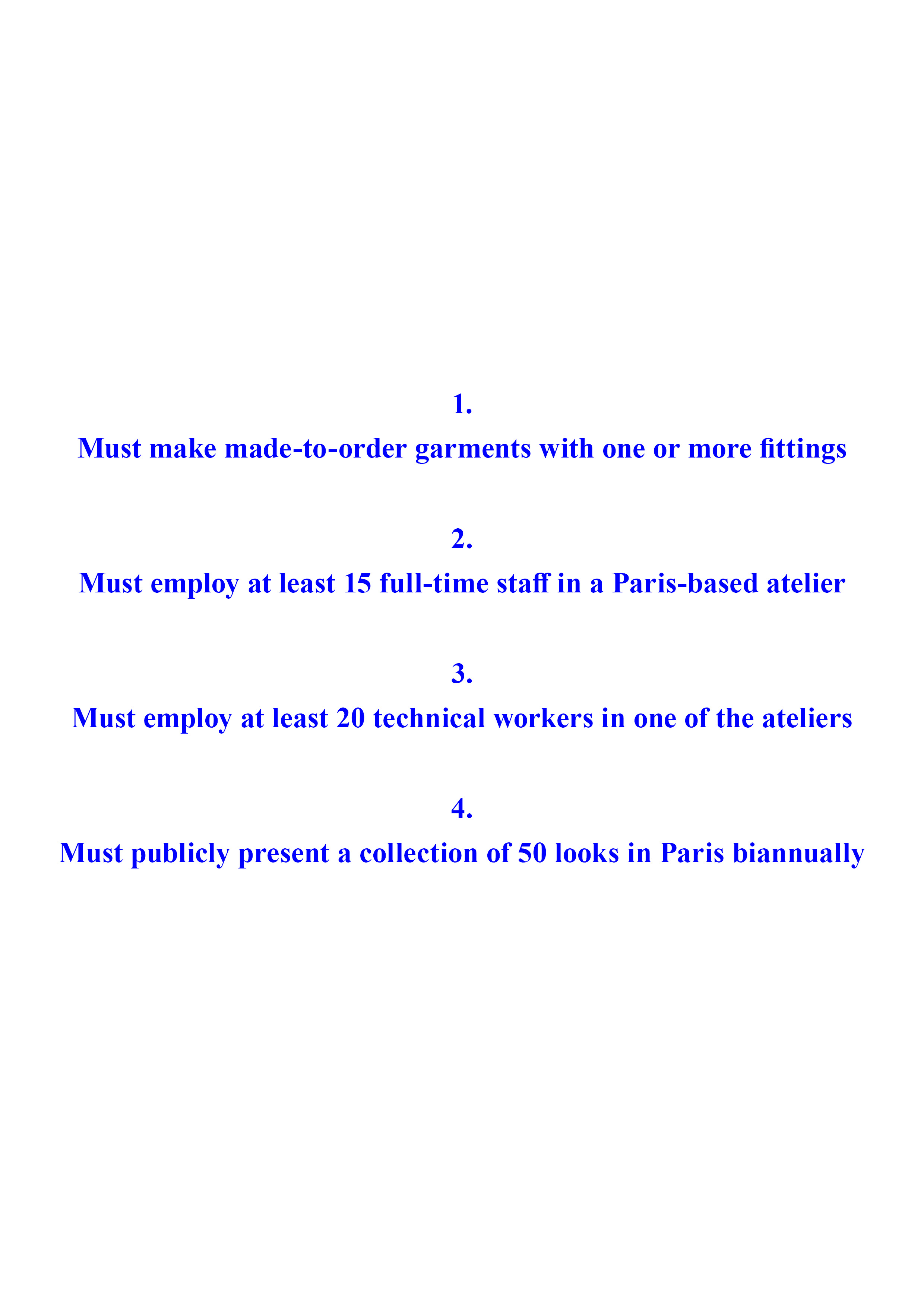
Made in Japan France
Failure of a system, Fashion, Production, Consumption, Waste, Global, Economy, Commercial, Manifesto
Through a quartet of seemingly simple rules, the Fédération de la Haute Couture et de la Mode has been safeguarding the official haute couture designation since 1945. Overseen by France’s Ministry of Industry, fashion’s most exclusive sector thus is legally bound to Paris’ territory.1 Although now only a minor part of the larger luxury fashion economy, haute couture still stands at the core of Paris’ status as a fashion capital. Some of the city’s most illustrious Maisons, like Christian Dior, Chanel, and Givenchy, are still dedicated to creating the one-of-a-kind, largely hand-made garments that are so specifically protected. Moreover, international luxury brands like Elie Saab, Viktor & Rolf, and Yuima Nakazato similarly flock to Paris to present haute couture collections twice a year. There is no doubt that the air of quality and innovation connected to the sector, contribute to making Paris the most attractive of the four fashion capitals for international designers to settle.2
This seems also true for a number of Japanese designers, many of whom have decided to show their work during Paris Fashion Week. Comme des Garçons, Issey Miyake, Kenzo, and Yohji Yamamoto, are among the brands that have introduced their collections in France’s capital. Frédéric Godart argues that this brain drain of talent to Paris, which is still regarded the epitome of fashion by many Japanese, has prevented Tokyo from growing into a major fashion capital itself.3 With a thriving design industry, a tradition of quality manufacturing, and a booming luxury market, the city otherwise has all the necessary ingredients. The success on the part of France’s authorities regarding luxury fashion, is perhaps a failure on the part of Japan’s counterparts. Protectionism in Japan has rather served high-tech industries producing automobiles and electronic devices, thus creating one of the world’s most powerful economies in a very different industry, on very similar terms.4
1. Divya Bala, “Everything You Need To Know About The Inner Workings Of Haute Couture,” Vogue.co.uk. Accessed March 8, 2020. https://www.vogue.co.uk/article/behind-the-scenes-at-haute-couture
2. Frédéric Godart, “The Power Structure of the Fashion Industry: Fashion Capitals, Globalization and Creativity,” International Journal of Fashion Studies 1, no. 1 (2014): 51-52.
3. Ibid., 47.
4. John West, “As Global Protectionism Rises, Japan Emerges as Asia’s Free Trade Champion,” BrinkNews.com. Accessed March 8, 2020. https://www.brinknews.com/as-global-protectionism-rises-japan-emerges-as-asias-free-trade-champion/.
Ephemera: 01
Failure of a system, Fashion, Production, Consumption, Waste, Global, Economy, Commercial, Manifesto
Through a quartet of seemingly simple rules, the Fédération de la Haute Couture et de la Mode has been safeguarding the official haute couture designation since 1945. Overseen by France’s Ministry of Industry, fashion’s most exclusive sector thus is legally bound to Paris’ territory.1 Although now only a minor part of the larger luxury fashion economy, haute couture still stands at the core of Paris’ status as a fashion capital. Some of the city’s most illustrious Maisons, like Christian Dior, Chanel, and Givenchy, are still dedicated to creating the one-of-a-kind, largely hand-made garments that are so specifically protected. Moreover, international luxury brands like Elie Saab, Viktor & Rolf, and Yuima Nakazato similarly flock to Paris to present haute couture collections twice a year. There is no doubt that the air of quality and innovation connected to the sector, contribute to making Paris the most attractive of the four fashion capitals for international designers to settle.2
This seems also true for a number of Japanese designers, many of whom have decided to show their work during Paris Fashion Week. Comme des Garçons, Issey Miyake, Kenzo, and Yohji Yamamoto, are among the brands that have introduced their collections in France’s capital. Frédéric Godart argues that this brain drain of talent to Paris, which is still regarded the epitome of fashion by many Japanese, has prevented Tokyo from growing into a major fashion capital itself.3 With a thriving design industry, a tradition of quality manufacturing, and a booming luxury market, the city otherwise has all the necessary ingredients. The success on the part of France’s authorities regarding luxury fashion, is perhaps a failure on the part of Japan’s counterparts. Protectionism in Japan has rather served high-tech industries producing automobiles and electronic devices, thus creating one of the world’s most powerful economies in a very different industry, on very similar terms.4
1. Divya Bala, “Everything You Need To Know About The Inner Workings Of Haute Couture,” Vogue.co.uk. Accessed March 8, 2020. https://www.vogue.co.uk/article/behind-the-scenes-at-haute-couture
2. Frédéric Godart, “The Power Structure of the Fashion Industry: Fashion Capitals, Globalization and Creativity,” International Journal of Fashion Studies 1, no. 1 (2014): 51-52.
3. Ibid., 47.
4. John West, “As Global Protectionism Rises, Japan Emerges as Asia’s Free Trade Champion,” BrinkNews.com. Accessed March 8, 2020. https://www.brinknews.com/as-global-protectionism-rises-japan-emerges-as-asias-free-trade-champion/.
Ephemera: 01


